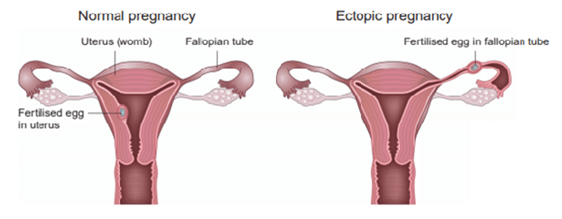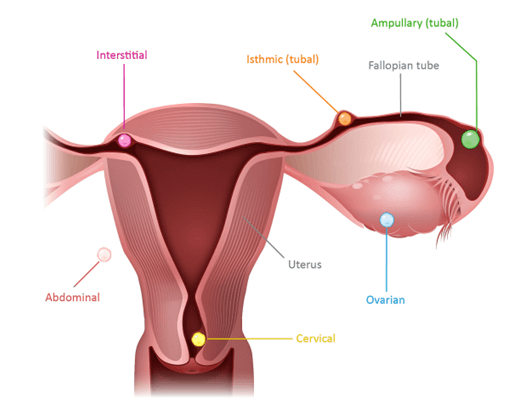Sites of Ectopic Pregnancy
An ectopic pregnancy is a pregnancy which grows outside the uterus (womb). 1 in 90 pregnancies in the UK is an ectopic pregnancy.
In a normal pregnancy, the fertilised egg moves from the Fallopian tube into the womb, where it implants, and the pregnancy develops. In an ectopic pregnancy, the fertilised egg can implant and start to develop in a number of locations outside the womb.

The location of the pregnancy affects the way in which the ectopic pregnancy is treated and can affect the likelihood of complications.
The image below shows the different locations where an ectopic pregnancy can develop:

More information on how an ectopic pregnancy is diagnosed and treated can be found in the ‘For Patients’ of the website, located here – What are the symptoms and signs?
Tubal Ectopic
The most common site for an ectopic pregnancy to implant is the Fallopian tube (the tubes stretching from the uterus to the ovaries, which the fertilised egg passes through on its way to the womb in a normal pregnancy). Over 90% of ectopic pregnancies are located within the tubes.
Approximately 70% of ectopic pregnancies are located within the ampulla, which is the widest portion of the tube, at the ovarian end. 12% are located in the isthmic portion of the tube, which is the narrower part of the tube that links to the uterus, and 11% are found in the fimbriae, the finger- like projections which surround the ovary.
Ovarian Ectopic
Ectopic pregnancies located on the ovary itself are one of the rarest varieties. The main significance of this diagnosis is that, if surgical management is required, it is likely to involve removing the affected ovary itself, as well as the pregnancy. This operation is called an oophorectomy. As long as the remaining ovary is healthy, it is still possible to get pregnant naturally.
Heterotopic Pregnancy
This is a very rare type of multiple pregnancy, in which one viable pregnancy develops within the uterus, and another fertilised egg is implanted elsewhere as an ectopic pregnancy. It occurs in less than 1 in 30,000 naturally occurring pregnancies, and is slightly more common in couples who conceive through assisted conception.
A heterotopic pregnancy can be challenging to treat, due to the risks to the viable pregnancy. Treatment would be surgical, using laparoscopy (keyhole) or laparotomy (open surgery) to remove the ectopic pregnancy. It is possible for the viable pregnancy within the uterus to continue to grow as a healthy pregnancy.
Caesarean Scar Pregnancy
Rarely, the ectopic pregnancy can be located at the site of the scar from a previous Caesarean section. This occurs in 1 in 1,800 pregnancies.
If the woman is well, it can be treated medically with methotrexate. If the woman is unwell, it is safest to be managed surgically. Caesarean scar pregnancy has a higher risk of bleeding if it were to rupture during surgical treatment.
More information on Caesarean Scar Ectopic Pregnancy can be found in the ‘For Professionals’ section of the website, located here – Caesarean Scar ectopic pregnancy
Cervical Ectopic
A cervical ectopic, in which the pregnancy implants on the cervix itself, is very rare. Most cervical pregnancies will result in miscarriage. The risk of bleeding, either with spontaneous miscarriage, or for those which require surgical intervention, is much higher.
Rare sites for Ectopic Pregnancy
Other possible locations for ectopic pregnancy are within the interstitium, the abdomen or the cervix.
Interstitial ectopic pregnancies are those which occur in the tissue of the Fallopian tube that lies within the muscular wall of the uterus. It can be quite difficult to diagnose through ultrasound, and may need laparoscopic (keyhole) surgery to confirm the diagnosis. If surgical management is needed, the operation can be more challenging.
Further reading
The images used in this article are from the RCOG Patient Information leaflet on ‘Ectopic Pregnancy’, which contains further reading on the diagnosis and management of ectopic pregnancy.
Dr Rhian Gisby
Obstetrics & Gynaecology Registrar
April 2021